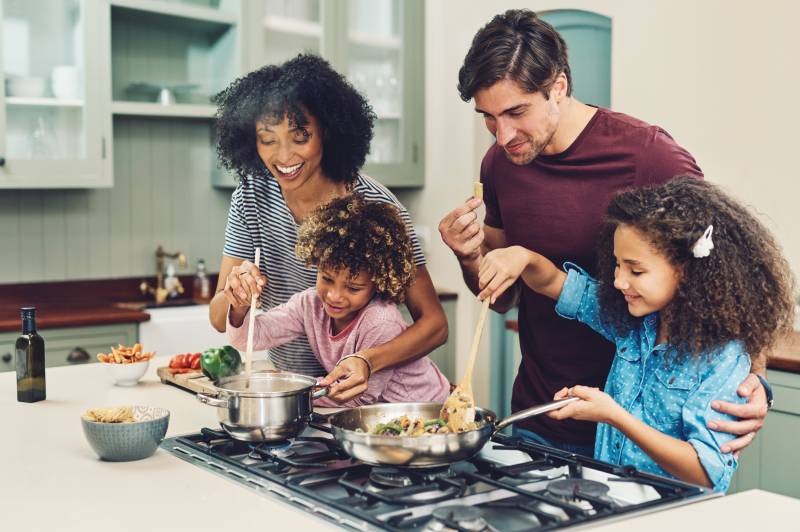- Neelam Patil, chef, educator and CEO of Bliss Belly Kitchen, a cooking summer camp in Berkeley.
- Vanessa Silva, food engineer and CEO of Culinary Artistas, a cooking school in San Francisco.
This conversation has been edited for length and clarity.
Young kids? Start simple with cooking …
Vanessa Silva: What I like to tell parents is: Start young. Start simple. There’s so many activities that you can share with the kid in the kitchen that starts this positive, successful relationship between them and food.
Let’s say you have a 2-year-old. You can get them to just pluck herbs — maybe wash the herbs. Kids love to play with water. Get them to smell the herbs; get them to see the colors.
From then on, chopping is something that every kid loves to do. Start with things that are soft, [like] fruit. You can do bananas, you can do berries. That’s something that they can get going [on] right away.
… and remove the pressure
Silva: A great way to remove any anxiety: make time to cook with your kids [that is separate] from when you’re trying to make dinner and put it on the table.
If you only have 15 minutes or half an hour, that’s okay. But you are not rushing — you are not putting that pressure on the kid.
Kids are really good at feeling their parents’ anxiety. So take that pressure away from the beginning; help them just have fun with it. Remember that this is a bonding activity, not something [that makes them feel] that they’re a burden to their parents.
Set young kids up for success with child-safe equipment
Neelam Patil: There are certain tools you can buy for your child, like a child-safe knife with a stubby handle and a zigzag … Those are knives that children can use even from the age of a toddler. They’re strong enough to cut harder vegetables like potatoes, carrots and celery, but it’s impossible to cut yourself.
You have to think of [cooking] like learning to ride a bike. When your child is learning to ride a bike independently, they’re going to fall. Allow them that space to make mistakes.
How busy parents can get teens to help out in the kitchen
Patil: Dealing with high schoolers is challenging. Maybe put aside an hour in the week where … the whole family is meal prepping.
What I like to call “meal prepping” is: I actually don’t like to cook large batches of food and store them in the kitchen … [Instead,] I like to chop vegetables ahead of time and just have them available in containers, so then I can immediately grab a handful of chopped kale or a handful of chopped zucchini, and make whatever dish I want to make. Involve them in that.
When you’re running from one practice, you’re picking up one kid, and you’re dropping off another, and then you come in, and there’s nothing made, and you have to make dinner — and everyone’s hungry. So what are you gonna do? If you train all your kids in knife skills, then everyone can participate together.
Instead of reheating something that’s frozen, you can create something together [with your prepped ingredients]. Some of that is a learning curve, and it’s going to take some structure and planning on the parents’ part. But it’s a worthwhile investment.
How to get kids excited about cooking healthy foods
Patil: I follow a system called Ayurveda, which is the sister science to yoga. It’s all about health, lifestyle and nutrition. According to Ayurveda, you have different [life stages]. When you’re young, your tastes are different. So young children actually prefer sweeter food … You may notice that they are craving carbohydrates and they want pasta with butter and cheese, and nothing else.
Know that this is part of their age, but also set expectations that vegetables are going to be part of every meal.
Silva: About ten years ago, I went back to school … to study holistic nutrition. My thesis was [about] how to entice kids to eat wholesome foods without bringing the concept of “healthy foods.” There are three things that I found in my research:
The first one is [fully engage] in the process from the beginning of picking an ingredient, an herb or a theme, all the way to cooking.
The second one is positive peer pressure … having an environment where other people are genuinely interested in trying something. This might be in a class or with the family.
The third one is absorbing and observing the excitement of the people around them and forming great memories around that food … If your kid is not yet interested in healthy foods, just keep [these foods] around. Keep being excited about it. Kids really pick up on their parents. I’m actually against the concept of hiding vegetables in the food. Bring them to the surface, highlight them, and know that at some point, their curiosity will come around it.
Another way … to get kids to be more interested in healthy foods is the concept of 80–20, which you can apply to everybody. If 80% of the foods that you’re being exposed to — that you’re cooking and eating — are wholesome foods, for the other 20%, I know I’m not going to pick a fight with my daughter’s Hot Cheetos.
But 80% of the time, we are eating great foods.

